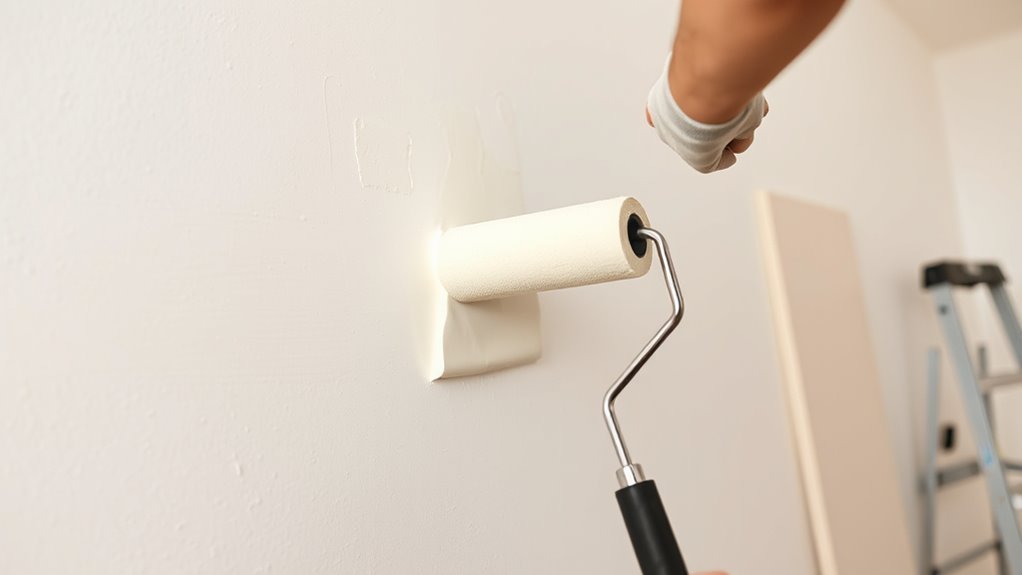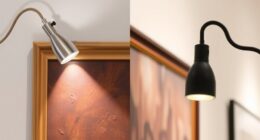To paint new drywall effectively, start by cleaning the surface thoroughly to remove dust. Apply a PVA primer evenly using a roller or brush, making sure to cover all areas and fill in minor imperfections. Allow the primer to dry completely, usually 1-2 hours, before painting. Proper preparation guarantees better adhesion and a smooth finish. If you keep going, you’ll discover more tips to make your drywall project flawless.
Key Takeaways
- Clean drywall thoroughly to remove dust and debris before applying PVA primer.
- Apply a thin, even coat of PVA primer using a roller or brush, focusing on seams and joints.
- Allow the primer to dry for 1-2 hours or as recommended by the manufacturer.
- Ensure the primer is completely dry to create a uniform, sealed surface for painting.
- Proceed with painting once the primer has dried thoroughly for optimal adhesion and finish.

Painting drywall can substantially enhance the look and durability of your walls, but proper preparation is essential. One of the key steps before applying your finish coat is using a PVA primer, which helps seal the surface and creates a uniform base. When choosing a primer, you’ll find that texture options can influence the final appearance of your walls. For example, if your drywall has a rough or uneven surface, selecting a primer that can fill minor imperfections will give you a smoother finish. Conversely, if your drywall is already smooth, a thinner primer might suffice. Knowing your texture options helps you decide whether you need a primer that adds a bit of thickness or one that’s more transparent.
Once you’ve chosen the right primer, it’s crucial to understand the primer drying time. The drying time varies depending on the product, humidity, and temperature, but generally, you should allow at least 1 to 2 hours for the primer to dry thoroughly before applying paint. Rushing this step can lead to peeling or uneven paint adhesion, so patience is vital. During this drying period, avoid touching the surface or applying additional coats prematurely. Proper drying ensures the primer forms a solid, uniform base that will improve paint adhesion and durability.
Applying the primer properly is straightforward if you follow some basic steps. Start by cleaning the drywall surface to remove dust and debris. Then, use a high-quality brush or roller to evenly coat the drywall with primer. Be mindful of overlapping strokes to prevent lap marks. If your drywall has joints or holes, spot-prime those areas first, then cover the entire surface once the repairs are sealed. After applying the primer, allow it to dry completely, respecting the recommended drying time. This step is crucial because it impacts how well the paint will adhere and how smooth the finished surface will look.
Frequently Asked Questions
Can I Skip the Primer When Painting New Drywall?
You can skip the primer when painting new drywall, but it’s not recommended. Primer enhances adhesion, ensuring your paint sticks well and lasts longer. Proper drywall preparation, including cleaning and smoothing surfaces, helps achieve a better finish without primer, but using a PVA primer is best for sealing the drywall and preventing issues like uneven texture or peeling. Skipping primer may lead to less durable, uneven results over time.
How Long Should I Wait Before Painting Over PVA Primer?
Don’t jump the gun before the paint dries, or you’ll be asking for trouble later. You should wait at least 24 hours after applying PVA primer before painting over it. Proper drywall preparation includes allowing the primer enough time to dry completely, ensuring a smooth, even finish. Keep in mind, primer drying time can vary depending on humidity and temperature, so double-check that the surface feels dry to the touch.
Is PVA Primer Suitable for All Types of Drywall Surfaces?
PVA primer is generally suitable for most drywall surfaces, but you should verify for primer compatibility with your specific drywall texture. It works well on smooth or lightly textured drywall, providing a good base for paint. However, if your drywall has a heavy texture or special finishes, consider using a primer designed for those surfaces. Always test a small area first to ensure proper adhesion and finish.
What Are the Best Alternative Primers for Drywall?
Think of primers like different tools in your toolbox; each suits a specific job. For drywall, you might choose oil-based primers for stains, shellac primers for odor blocking, or latex primers for general sealing. These primer types employ varied sealing techniques, ensuring your surface is prepared for paint. Picking the right primer enhances adhesion and smoothness, making your project easier and the finish more durable.
How Do I Fix a Peeling or Bubbling Primer Coat?
To fix peeling or bubbling primer, start by scraping off the loose areas carefully. Sand the surface smooth to prevent future peeling and bubbling. Clean the drywall thoroughly to remove dust and debris. Apply a high-quality primer, guaranteeing proper adhesion and peeling prevention. Be patient and wait for the primer to fully dry before painting. This process helps repair bubbling and ensures a smooth, durable finish.
Conclusion
Think of your drywall as a blank canvas, waiting for your touch to bring it to life. By applying PVA primer and following these steps, you’re not just preparing a surface—you’re laying the foundation for your masterpiece. Each brushstroke symbolizes your transformation from an empty space to a vibrant room filled with possibility. Embrace the process, knowing that your effort now paints the future of your home with color, character, and warmth.









